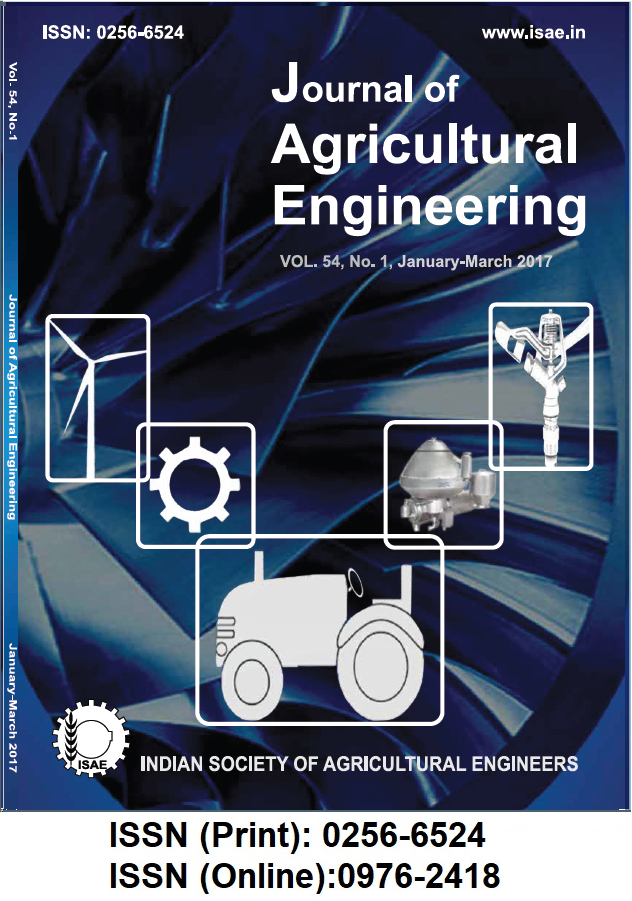Impact of Transplanting Date and Irrigation Scheduling on Water Balance, Water Productivity and Soil Moisture Movement
DOI:
https://doi.org/10.52151/jae2017541.1618Keywords:
Water balance, water productivity, irrigation scheduling, hydrus-2D, soil moistureAbstract
The study investigated the impact of transplanting date and irrigation scheduling on water balance, water productivity, and soil moisture movement in puddled transplanted rice (PTR). Rice transplanted on June 20th (T2 ) contributed to lesser water losses (ET=75.0 mm and drainage=48.5 mm) than that of June 5th transplanted rice (T1 ), and significantly saved 164 mm of irrigation water. Treatment T2 resulted in higher irrigation water productivity (WPI =0.19 g.kg-1) and total water productivity (WPI+R=0.08 g.kg-1) than that of treatment T1 . In terms of method of irrigation, the irrigation scheduling based on tensiometer (I2 -SWS of 16 kPa) contributed to 104.5 mm lesser drainage loss and saved 120 mm irrigation water than that of irrigation scheduling based on intermittent 2-day drainage (I1 ). Irrigation method I2 contributed to yield higher water productivities (WPI =0.058 g.kg-1 and WPI+R=0.003 g.kg-1) than that of irrigation method I1 . The soil moisture movement study was conducted by using hydrus-2D model. The model simulations were compared with the field data. An acceptable agreement between model simulations and field data was achieved.
References
Bouman B A M; Tuong T P. 2001. Field water management to save water and increase its productivity in irrigated rice. Agric. Water Manage., 49, 11-30.
Dudley U; Shani L M. 2003. Modelling plant response to draught and salt stress: reformulation of the root-sink term. Vadose Zone J., 2, 751-758.
Goncalves M C; Simunek J; Romos T B; Martin J C; Neves M J; Pires F P. 2005. Using Hydrus to simulate water and solute transports in soil lysimeters. In: Proc. Workshop on Hydrus Application at Utrecht University, Netherland, 38-41.
Humphreys E; Kukal S S; Christen E W; Hira G S; Singh Balwinder; Yadav Sudhir; Sharma R K. 2010. Halting the groundwater decline in north-west India—which crop technologies will be winners? Advances Agron., 109, 155–217.
Li Y. 2001. Research and practice of water saving irrigation for rice in China. In: Barker R; Loeve R; Li Y; Tuong TP (Eds.) Water-Saving Irrigation for Rice. Proc. International Workshop, Wuhan, China, International Water Management Institute, Colombo, Sri Lanka, March 23–25, 135-144.
Nash J E; Sutcliffe J V. 1970. River flow forecasting through conceptual models part I-A discussion of principles. J. Hydrol., 10, 282–290.
Rodell M; Velicogna I; Famiglietti J S. 2009. Satellite-based estimates of groundwater depletion in India. Nature, 460, 999-1002.
Schaap M G; Leij F J; Van Genuchten M T. 2001. Rosetta-a computer programme for estimating soil hydraulic parameters with hierarchical pedotranfer functions. J. Hydrol., 251, 163-176.
Shani U; Tsur Y; Zemel A. 2004. Optimal dynamic irrigation schemes. Optim. Control Appl. Methods, 25, 91-106.
Simunek J; van Genuchten M T; Sejna M. 2008. Development and applications of HYDRUS and STANMOD software packages and related codes. Vadose Zone J., 7, 587-600.
Singh M C; Jain A K; Garg S. 2013. Simulation of soil moisture movement under rice field using Hydrus-2D. Crop Res., 45, 45-53.
Tabbal D F; Bouman B A M; Bhuiyan S I; Sibayan E B; Sattar M A. 2002. On-farm strategies for reducing water input in irrigated rice: case studies in the Philippines. Agric. Water Manage., 56, 93-112.
Tan X; Shao D; Liu H. 2014. Simulating soil water regime in lowland paddy fields under different water managements using HYDRUS-1D. Agric. Water Manage., 132, 69-78.
Tuong T P; Bouman B A M. 2003. Rice production in water scarce environments. In: Kijne JW; Barker R; Molden D (Eds.). Water Productivity in Agriculture: Limits and Opportunities for Improvement, CABI Publishing, U.K., 53-67.
Van Genuchten M T. 1980. A closed form equation for predicting hydraulic conductivity of unsaturated soils. Soil Sci. Soc. Am. J., 44, 892-898.
Wang H; Bouman B A M; Zhao D; Wang C; Moya P F. 2002. Aerobic rice in northern China- opportunities and challenges. In: Bouman B A M; Hengsdijk H; Hardy B; Bindraban P S; Tuong T P; Ladha J K (Eds.). Proc. International Workshop on Water-Wise Rice Production, International Rice Research Institute, Los Banos, Philippines, April 8-11, 143-54.
Yadav Sudhir; Gill G; Kukal S S; Humphreys E; Rangarajan R; Walia U S. 2010. Water balance in dry seeded and puddled transplanted rice in Punjab, India. In: 19th World Congress of Soil Science, Soil Solutions for a Changing World, 1-6 August, Brisbane, Australia, 43-46.
Yadav Sudhir; Tao L; Humphreys E; Gill G; Kukal S S. 2011. Evaluation and application of ORYZA 2000 for irrigation scheduling of puddled transplanted rice in north-west India. Field Crops Res., 122,104-117.














